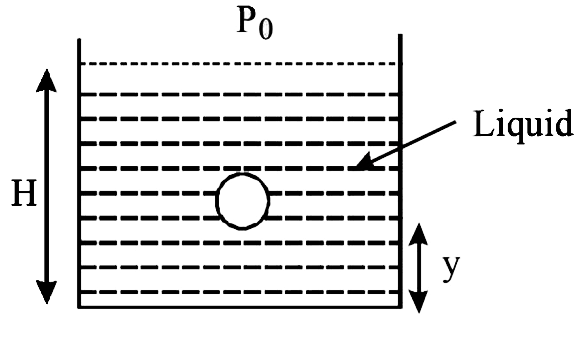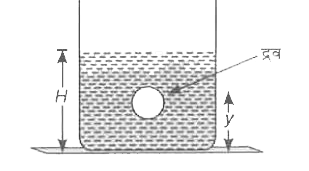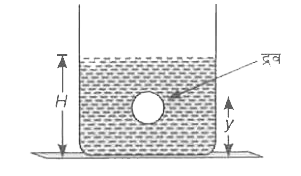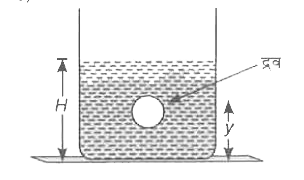A small spherical monoatomic ideal gas bubble (γ=5/3) is trapped inside a liquid of density ρ (see figure). Assume that the bubble does not exchange any heat with the liquid. The bubble contains n moles of gas. The temperature of the gas when the bubble is at the bottom is T0, the height of the liquid is H and the atmospheric pressure P0 (Neglect surface tension).

As the bubble moves upwards, besides the buoyancy force the following forces are acting on it Solution in Gujrati
Only the force of gravity
The force due to gravity and the force due to the pressure of the liquid
The force due to gravity, the force due to the pressure of the liquid and the force due to viscosity of the liquid.
The force due to gravity and the force due to viscosity of the liquid.
The correct Answer is:D
Force due to the pressure of liquid = The buoyancy force.
Topper's Solved these Questions
- GEOMETRICAL OPTICSBOOK - ALLEN CHAPTER - GEOMETRICAL OPTICSEXERCISE - EXERCISE- 01
45 Videos
- GEOMETRICAL OPTICSBOOK - ALLEN CHAPTER - GEOMETRICAL OPTICSEXERCISE - EXERCISE-2
44 Videos
- GEOMETRICAL OPTICSBOOK - ALLEN CHAPTER - GEOMETRICAL OPTICSEXERCISE - EXERCISE - 05 (B) (MATCH THE COLUMN)
3 Videos
- CURRENT ELECTRICITYBOOK - ALLEN CHAPTER - CURRENT ELECTRICITYEXERCISE - EX.II
66 Videos
- GRAVITATIONBOOK - ALLEN CHAPTER - GRAVITATIONEXERCISE - EXERCISE 4
9 Videos
Similar Questions
Two plane mirror M1andM2 are inclined to each other at 70∘. A ray incident on the mirror M1 at an angle θ fallls on M2 and is then reflected parallel to M1 for
View SolutionTwo mirrors are inclined at angle θ as shown in figure. Light rays are incident parallel to one of mirrors. Light will start retracing its path after the reflection if
View SolutionFor the given process :-
_E01_426_Q01.png)
Column-IColumn-II(A)Process J→K(P)W>0(B)Process K→L(q)W<0(C)Process L→M(r)Q>0(D)Process M→J(s)Q<0
View SolutionIn the Bohr's model of hy drogen atom, the electron moves around the nucleus in a circular orbit of radius 5×10−11m. Its time period is 1.5×10−16s. The current associated with the electron motion is:-
View SolutionAssertion : The difference in the value of acceleration due to gravity at pole and equator is proportional to square of angular velocity of earth.
Reason : the value of acceleration due to gravity is minimum at the equator and maximum at the pole.
View SolutionA small spherical monoatomic ideal gas bubble (gamma=5//3) is trapped inside a liquid of density rho (see figure). Assume that the bubble does not exchange any heat with the liquid. The bubble contains n moles of gas. The temperature of the gas when the bubble is at the bottom is T_0 , the height of the liquid is H and the atmospheric pressure P_0 (Neglect surface tension). As the bubble moves upwards, besides the buyoncy force the following forces are acting on it
View SolutionA small spherical monoatomic ideal gas bubble (gamma=5//3) is trapped inside a liquid of density rho (see figure). Assume that the bubble does not exchange any heat with the liquid. The bubble contains n moles of gas. The temperature of the gas when the bubble is at the bottom is T_0 , the height of the liquid is H and the atmospheric pressure P_0 (Neglect surface tension). When the gas bubble is at a height y from the bottom, its temperature is-
View SolutionA small spherical monoatomic ideal gas bubble (gamma=5//3) is trapped inside a liquid of density rho (see figure). Assume that the bubble does not exchange any heat with the liquid. The bubble contains n moles of gas. The temperature of the gas when the bubble is at the bottom is T_0 , the height of the liquid is H and the atmospheric pressure P_0 (Neglect surface tension). The buyoncy force acting on the gas bubble is (Assume R is the universal gas constant)
View SolutionA small spherical monoatomic ideal gas bubble (γ=53) is trapped inside a liquid of density ρl (see figure) . Assume that the bubble does not exchange any heat with the liquid. The bubble contains n moles of gas. The temperature of the gas when the bubble is at the bottom is T0, the height of the liquid is H and the atmospheric pressure is P0 (Neglect surface tension).
_E01_434_Q01.png)
When the gas bubble is at a height y from the bottom , its temperature is :-
View SolutionA small air bubble of radius r in water is at depth h below the water surface. If P_0 is the atmospheric pressure, rho is the density of water and T is the surface tension of water, what is the pressure inside the bubble?
View Solutionएकपरमाणुक आदर्श गैस का छोटा बुलबुला (γ=53),ρl घनत्व वाले द्रव से घिरा हुआ है। माना कि यह बुलबुला द्रव से किसी प्रकार का ऊष्मीय आदान-प्रदान नहीं करता। बुलबुले में गैस के n मोल है। बुलबुला जब तली में स्थित है तब गैस का ताप T0 है, द्रव स्तम्भ की ऊँचाई H है तथा वायुमंडलीय दाब p0 है (पृष्ठ तनाव नगण्य है)
जैसे-जैसे बुलबुला ऊपर की ओर गति करता है, उत्प्लावन बल के अतिरिक्त जो बल उस पर कार्य करते है,वह है-

View Solutionएकपरमाणुक आदर्श गैस का छोटा बुलबुला (γ=53)ρl घनत्व वाले द्रव से घिरा हुआ है। माना कि यह बुलबुला द्रव से किसी प्रकार का ऊष्मीय आदान-प्रदान नहीं करता। बुलबुले में गैस के n मोल है। बुलबुला जब तली में स्थित है तब गैस का ताप T0 है, द्रव स्तम्भ की ऊँचाई H है तथा वायुमंडलीय दाब p0 है (पृष्ठ तनाव नगण्य है)

जब बुलबुला बर्तन की तली से y ऊँचाई पर हो, तब उसका ताप होगा
View Solutionएकपरमाणुक आदर्श गैस का छोटा बुलबुला (γ=53)ρl घनत्व वाले द्रव से घिरा हुआ है। माना कि यह बुलबुला द्रव से किसी प्रकार का ऊष्मीय आदान-प्रदान नहीं करता। बुलबुले में गैस के n मोल है। बुलबुला जब तली में स्थित है तब गैस का ताप T0 है, द्रव स्तम्भ की ऊँचाई H है तथा वायुमंडलीय दाब p0 है (पृष्ठ तनाव नगण्य है)

गैस के बुलबुले पर कार्य करने वाला उत्प्लावन बल (R सार्वत्रिक गैस नियतांक है) होगा
View SolutionPassage - II :
A small spherical monoatomic ideal gas bubble (γ−53) is trapped inside a liquid of density ρ1 [ see figure]. Assume that the bubble does not exchange any heat with the liquid. The bubble contains n moles of gas. The temperature of the gas when the bubble is at the bottom is T0. the height of the liquid is H and the atmospheric pressure is ρ0 ( Neglect surface tension)

As the bubble moves upwards, besides the buoyancy force the following forces are acting on it.
View SolutionPassage - II :
A small spherical monoatomic ideal gas bubble (γ−53) is trapped inside a liquid of density ρ1 [ see figure]. Assume that the bubble does not exchange any heat with the liquid. The bubble contains n moles of gas. The temperature of the gas when the bubble is at the bottom is T0. the height of the liquid is H and the atmospheric pressure is ρ0 ( Neglect surface tension)

When the gas bubble is at a height y from the bottom, its temperature is :
View SolutionPassage - II :
A small spherical monoatomic ideal gas bubble (γ−53) is trapped inside a liquid of density ρ1 [ see figure]. Assume that the bubble does not exchange any heat with the liquid. The bubble contains n moles of gas. The temperature of the gas when the bubble is at the bottom is T0. the height of the liquid is H and the atmospheric pressure is ρ0 ( Neglect surface tension)

The buoyancy force acting on the gas bubble is :
View Solution
